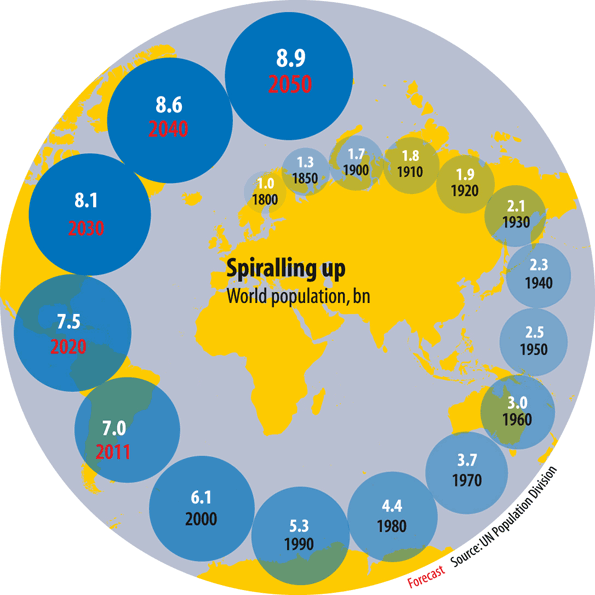October 31st, 2011, was 7 billion day, the day on which world population officially hit 7 billion. In honor of the momentous occasion, Sage did a quick and decidedly non-comprehensive roundup of the news–not only from this year, but also from the years of future and previous population milestones.
Rev up the time machine!
The Future:
World population is generally forecast to hit 9 billion by 2050, and, perhaps, stabilize by 2300. But the future remains stubbornly uncertain, as both Andrew Revkin and Yale e360 have noted. The Economist writes that feeding so many people will be hard.
2011: 7 Billion
National Geographic devotes a a year-long special series to the topic of population, including a video on the world’s most “typical” human (see below). The New York Times has a Joel Cohen Op-Ed on the subject of how the world will bear 7 billion, with nuance for both the Malthusians and Pronatalists, and a status report on major categories of resource use, consumption versus population issues, and much more. The Guardian puts together a great app that tells you what number baby you were.
The Daily Mail and many, many others have stories on cutie Danica May Camacho, the “7 billionth” baby (the number is symbolic–no one really knows).
From The Times:
Henceforth we need to measure our growth in prosperity: not by the sheer number of people who inhabit the earth, and not by flawed measurements like G.D.P., but by how well we satisfy basic human needs; by how well we foster dignity, creativity, community and cooperation; by how well we care for our biological and physical environment, our only home.
1999: 6 Billion
Though everyone is mostly worried about computer clocks messing up, the world takes a moment to note that it only took about 12 years for the world to gain its latest billion. The first billion took about a quarter of a million years. The introduction to this UN report has great charts and graphs. Full report here.
The sixth billionth child is Adnan Nevic of Sarajevo (The Guardian caught up with him for a profile in 2011.)
1987: 5 Billion
Reports on population from 1987 read like previews for the show we’re now living. Both the NY Times and The Guardian run Op-Eds with remarkably similar takes on the concerns we’re reading about this year, though with fewer details and less complexity. As The Guardian notes, one of the most striking facts about the relationship between 1987 and 2011 is how little of an impact calls to limit growth have had.
1974: 4 billion
There are now four billion people on the disco floor. The AP reports on the UN’s big meeting on population in Bucharest. The Population Bomb came out in 1968, and worries about population growth are prominent. But it’s also the first milestone where experts take note of a potential slowdown in the overall growth rate, as this AP report notes amidst some old-timey newspaper ads.
1962: 3 billion
This is the first milestone where population growth (particularly in the developing world) begins to be seen as a problem (at least by the developed world). Contraceptives enter into the equation. Also, burglars steal 200,000 dollars worth of gold, gems in Grand Rapids Michigan!
1930 or thereabouts: 2 billion
2 billion! That’s half the number that now have cell phones, and only twice the number who now live in poverty. The League of Nations compiles the figure. The one newspaper report we found is small, dwarfed by stories on the Great Depression and prohibition.
Pre-1930:
All is lost to the fog of time, and magazines without expensive researching tools. One billion probably happened sometime around 1800.
